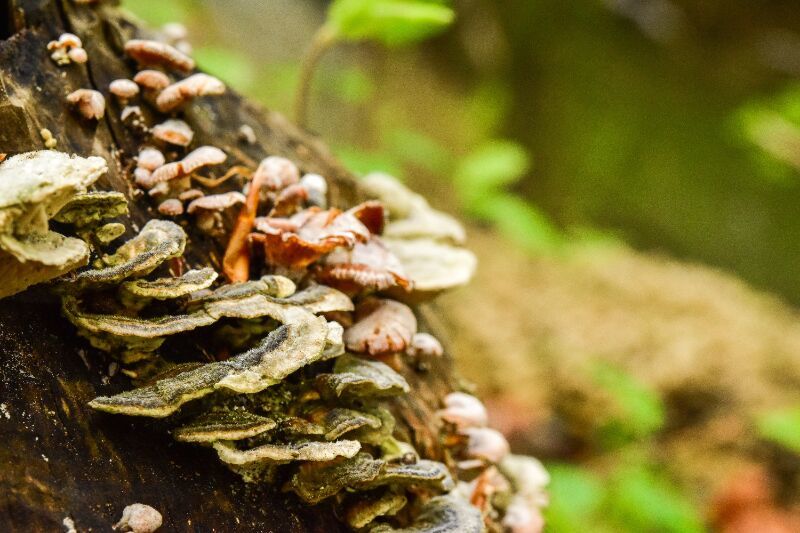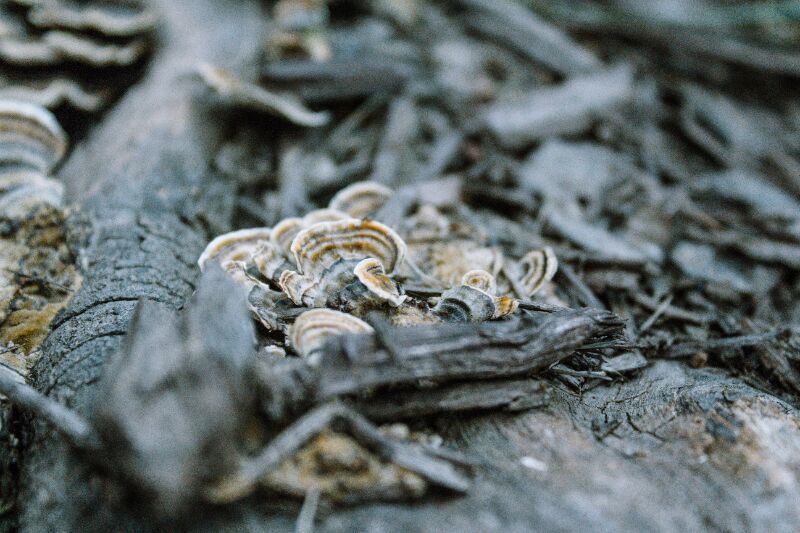Fungi Watch: What You Don't Want to See in Your Trees
Fungi are essential to most ecosystems, but some types can grow in places that cause more harm than good. Some fungi, especially those that grow on trees, can harm their host. At best, infected trees may look discoloured, dried out, or even burnt. At worst, a fungal infection like Dutch Elm disease can be lethal.
Below, we explore the signs of fungal infections in trees, what to do if you think your trees may be infected, and how Green Drop arborists protect your trees from serious and unsightly fungus.

Top Signs of Fungus in Your Trees
In most cases, prevention is critical to keeping your trees safe from exposure to fungal spores. If your trees are infected, identifying the problem quickly so treatment can begin as soon as possible is essential.
Some of the common signs of fungus include the following:
- Cankers on the bark of your trees – Cankers are discoloured bark areas that may look "sunken in" and are more common for hardwood trees than coniferous ones. These tend to be caused by fungal spores introduced to the tree via improper cutting.
- Dead spots on your tree leaves – Look for brown spots that resemble targets or bullseyes, sometimes with a purple ring around it. These can indicate a severe fungus called anthracnose, which may cause widespread damage to the entire tree. Healthy trees generally survive, especially if they are a disease-resistant species.
- White patches on leaves and branches – This may be caused by powdery mildew, a fungal disease that primarily affects trees in the shade versus trees growing in the sun. Crabapple and lilac trees are particularly susceptible to powdery mildew.
- Black patches instead of white ones – If you have a dark powdery substance on your tree leaves, this could indicate sooty mould. Despite what its name suggests, this disease is an ugly fungus, not a mould.
- Leaf rust – This common fungus causes gold, orange, or red spots on tree leaves that rob trees of their ability to photosynthesize. Leaf rust doesn't usually kill a tree, and multiple fungicide solutions are available to treat this largely cosmetic condition.
- Out-of-season wilting or browning – Wilting or browning in leaves can signify many diseases, pests, or fungi in your trees. If you notice your tree’s leaves turning brown during the growing season, it could be a fungus that needs quick treatment.
- Yellowing and curling of leaves – Leaves that are dry, yellow, and curled can be a sign of another serious wilt disease called verticillium wilt. Unfortunately, there are no fungicides that treat this soil-borne disease.
- Dieback and discoloration – Rapid dieback can be caused by crown rot, a quick-spreading soil fungus that infects the roots but remains largely undetectable until it reaches the tree's foliage. This condition is most common in shrubs and fruit trees.
Proper Fungus Protection
Taking steps to protect your trees from fungal infection is generally a better strategy than treating an infection that has already had an opportunity to proliferate. These simple yet effective tactics can reduce the chances that fungal spores will come into contact with your trees, and if they do, give your trees resilience against them.
Feed your trees
It’s a common misconception that feeding your trees will also feed any fungus living on them. Trees with plenty of nutrients are strong and healthy, meaning they can resist infection and disease better. Make sure you’re fertilizing your trees consistently with the right balance of nutrients to give them the strongest possible defence against harmful fungi.
Avoid overwatering and maintain adequate drainage
Moisture is a mushroom’s best friend, and trees that have been overwatered or have poor water drainage are much more susceptible to fungal growth. Excess water around the tree’s trunk can cause root rot and wilt diseases, some of which can’t be killed by currently available fungicides.
Don’t prune trees when it’s raining
Pruning or cutting your trees when the conditions are wet increases the risk of fungal spores reaching the inside of your tree, where they can cause severe vascular conditions. It’s also important to avoid contact with plants when wet after rain since you could easily transfer spores from vegetation that can tolerate them to trees that cannot.
Clean your tools between trees
If you handle any tree care yourself, you’ll want to ensure clean tools between different trees. Contaminated tools for tree trimming, pruning, or other maintenance can easily spread fungal infections between trees. There are a few methods you can use to clean your tools thoroughly between trees. One option is to use 90% or higher isopropyl alcohol, while another is a 1:4 mixture of bleach and water. You should also allow your tools to dry thoroughly before working on the next tree.

What to Do If You Have Tree Fungi
If you suspect that your trees already have a fungal infection, several things must be done to keep the issue from worsening. Early intervention is crucial to reducing potential damage to your trees.
Test the fungus to determine its type
Diagnostic testing can help you identify the kind of fungus you’re dealing with so you can better understand how to treat it. Some fungicides and other treatment methods are less effective for some fungi.
You can test the spores to get a better understanding of the problem before the start of treatment. A professional service can offer more in-depth testing and provide more insight than trying to go it alone. For our Winnipeg customers, Green Drop even has a plant diagnostic laboratory for many testing options.
Increase airflow around the affected trees
Fungus prefers to grow in dark, moist conditions. You can discourage fungal growth by increasing the amount of airflow and sunlight around affected trees. However, you must avoid over-pruning diseased trees.
Wounding a tree with a fungal infection can introduce pathogens into the open wounds and worsen the condition. Instead, prune healthy trees around the infected ones. If you do need to prune back dead or dying branches on an infected tree, be sure to properly sanitize your cutting tools first.
Reduce any stress on your trees
Trees impacted by drought, soil compaction, overwatering, and other stressors are more susceptible to fungal overgrowth than trees that are properly watered and fertilized for the season. Ask a professional tree expert to show you how to take care of the kind of trees you have and follow a regular schedule for watering, fertilizing, and maintaining the soil conditions of your trees.
Hire a professional
An experienced tree expert can help determine what kind of fungus your trees have and the most appropriate treatment. They can also help you learn how to prevent fungal infections for your other trees. Their experience in the industry provides a great base to understand and identify issues more quickly and thoroughly because of their access to technology and state-of-the-art tools.
Frequently Asked Questions (FAQs) About Tree Fungi
How do trees become infected with fungus?
Fungal spores can infect trees in several ways, only some of which you can prevent. Trees can become infected by dirty tools, poor environmental conditions, and spores blown from one tree to another by the wind.
Mycelium networks also run underground and spread from tree to tree via their root systems. Having a protocol you follow when caring for your trees can help reduce their risk of exposure.
Are fungi harmful to trees?
Some fungi are harmless to trees and only cause unsightly spots or browning. These conditions are only a visual problem and don’t pose any risk to the overall health of the tree. Other fungi are a more pressing issue and can potentially cause the death of young or weak trees. Even healthy trees can succumb to concerning diseases like oak wilt and Dutch Elm disease.
What is a fungicide?
A fungicide is a special solution that can be sprayed or otherwise applied to trees or other vegetation to kill fungal spores and prevent them from proliferating. The most common fungicides used to treat infected trees use copper as an active ingredient, which regulates fungi growth without causing harm to the vegetation underneath.
Does fungicide cure trees with fungal infections?
Unfortunately, it’s tough to completely eradicate a fungal infection once it’s already taken hold. That’s why prevention strategies are so crucial to employ.
Fungicides applied to trees externally and at the root system can help reduce the number of fungal spores but rarely eliminate them entirely. Good tree care is required after a fungal treatment since the tree can come out of remission and become infected again.
How Green Drop Can Help You Maintain Healthy Trees
Your trees are an investment in aesthetics and your property for the long haul. Green Drop’s certified arborists can help you develop a tree care strategy that helps prevent fungal infections and keep your trees strong and healthy.
Contact us today to learn more about the importance of proper tree care or to schedule your free estimate.

